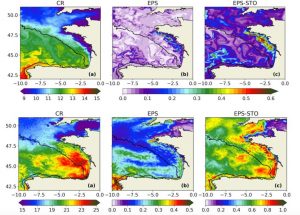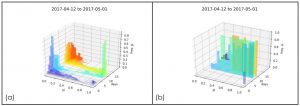STOCHASTIC COASTAL/REGIONAL UNCERTAINTY MODELLING (SCRUM) 2:
CONSISTENCY, RELIABILITY, PROBABILISTIC FORECASTING, AND CONTRIBUTION TO CMEMS ENSEMBLE DATA ASSIMILATION
PI and organization: S. Sarantis (Univ. of Athens)
Co-Is: V. Vervatis (Univ. of Athens), M Kailas (Univ. of Athens), P. de Mey (CNRS/LEGOS), N, Ayoub (CNRS/LEGOS)
The project aims at strengthening CMEMS in the areas of regional/coastal ocean uncertainty modelling, Ensemble consistency verification, Ensemble probabilistic forecasting, and Ensemble data assimilation. The work was based on stochastic modelling of ocean physics and biogeochemistry and included methods suitable to assess the empirical consistency of Ensembles and their suitability for probabilistic forecasting.
In a first step, we produced short- to medium-range Ensembles over repeated periods to mirror the MFC operational practices. This, permitted to take into account the Ensemble spin-up period and gives access to performance categorization based on the age of errors within a given forecast lead time.
In a second step, we focused on Ensemble empirical consistency and probabilistic scores (and associated statistical properties). Data from Thematic Assembly Centers (TAC) and arrays from the CMEMS catalogue were used, including Sentinel 3A data. The consistency analysis also addressed the question of which routinely-available surface datasets were fit for validating Ensembles.
In a third step, we concentrated on the assessment of the fitness of our Ensembles for probabilistic forecasting. Published algorithms for Probability Scores (PS) were implemented and tested on our error age-dependent Ensembles within a Quasi-Reliable testbed as well as with observations from the CMEMS catalog. We then concentrated on the probabilistic prediction of an upwelling event off Northern Spain and the application of the PS analysis to that event, on the way deriving guidelines towards the future implementation of PS in CMEMS systems.
Secondary objectives of the project were (1) to facilitate linkages between the data assimilation specialists of CMEMS MFCs and (2) to contribute to the CMEMS DA team guidance in support of upcoming decisions regarding the evolution of regional/coastal data assimilation schemes in CMEMS, engaging external experts.
 Figure 1. (a) Control run (CR) SST and (b-c) SST model uncertainties in degree C for the EPS and EPS-STO time-chunked Ensembles on two different periods and forecast lead times; upper panels: 20170208 (Lead time: 28-day), lower panels: 20170619 (Lead time:19-day). The EPS ensemble corresponds to a short- to medium-range time-chunked Ensemble incorporating the atmospheric ECMWF-EPS system. The EPS-STO ensemble combines a seasonal-range Ensemble incorporating the atmospheric ECMWF-EPS system with a stochastic time-chunked Ensemble incorporating the ECMWF-CTRL system.
Figure 1. (a) Control run (CR) SST and (b-c) SST model uncertainties in degree C for the EPS and EPS-STO time-chunked Ensembles on two different periods and forecast lead times; upper panels: 20170208 (Lead time: 28-day), lower panels: 20170619 (Lead time:19-day). The EPS ensemble corresponds to a short- to medium-range time-chunked Ensemble incorporating the atmospheric ECMWF-EPS system. The EPS-STO ensemble combines a seasonal-range Ensemble incorporating the atmospheric ECMWF-EPS system with a stochastic time-chunked Ensemble incorporating the ECMWF-CTRL system.
Figure 2. Diagrams in terms of Pi and days : (a) Left panel shows frequency of occurrence Gi; (b) shows the corresponding Reliability Diagram with oi the conditional frequency of occurrence when pi is issued. Pi are the probability classes, taking the discrete values {0,…,i/N,…,1}. Gi is the frequency of occurrence of having the ensemble predicting the probability Pi.



